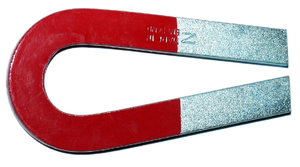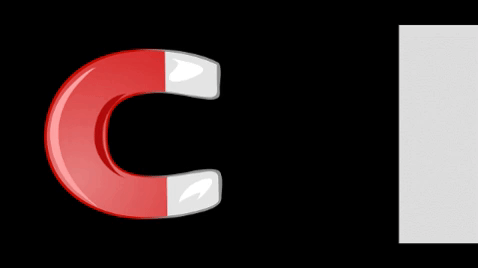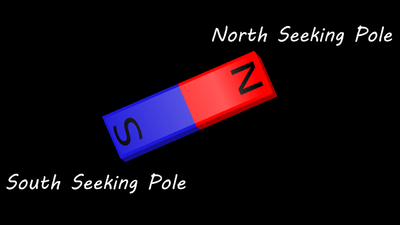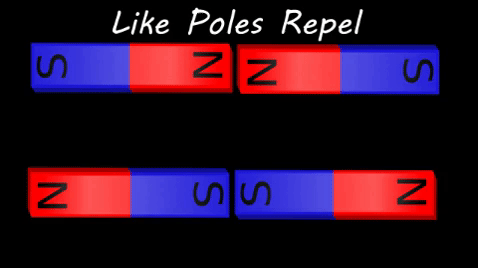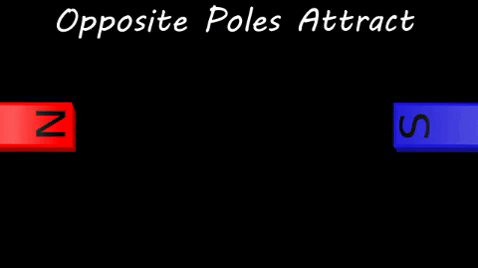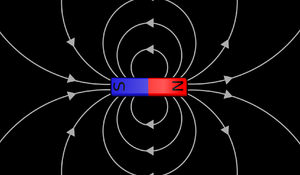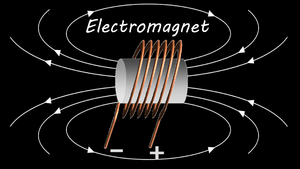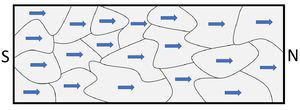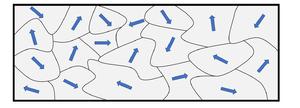Difference between revisions of "Magnet"
(Created page with "==Key Stage 2== ===Meaning=== right|300px|thumb|A horseshoe magnet A '''magnet''' is a piece of equipment that can be used to do determine if...") |
|||
| (22 intermediate revisions by 2 users not shown) | |||
| Line 1: | Line 1: | ||
| + | ==Key Stage 1== | ||
| + | ===Meaning=== | ||
| + | [[File:MagnetHorseshoe.png|right|300px|thumb|A horseshoe magnet]] | ||
| + | A '''magnet''' is an object that sticks to some [[metal]]s. | ||
| + | |||
| + | ===About Magnets=== | ||
| + | : '''Magnets''' are very useful. We can use them to stick notes to the fridge. | ||
| + | |||
==Key Stage 2== | ==Key Stage 2== | ||
===Meaning=== | ===Meaning=== | ||
| − | + | ||
| − | A '''magnet''' is a piece of [[equipment]] that can be used to do determine if | + | A '''magnet''' is a piece of [[equipment]] that can be used to do determine if a [[material]] is [[magnetic]]. |
: Singular [[Noun]]: '''Magnet''' | : Singular [[Noun]]: '''Magnet''' | ||
| Line 9: | Line 17: | ||
===About Magnets=== | ===About Magnets=== | ||
| − | : '''Magnets''' are attracted to some metals. Those metals are '''magnetic''' but they are not magnets themselves. | + | : '''Magnets''' are [[attract]]ed to some metals. Those metals are '''magnetic''' but they are not [[magnet]]s themselves. |
| − | : '''Magnets''' have two poles; North and South. | + | : '''Magnets''' have two [[poles]]; North and South. |
| − | : When two North Poles are placed next to each other two '''magnets''' will repel each other. | + | : When two North [[Poles]] are placed next to each other two '''magnets''' will [[repel]] each other. |
| − | : When two South Poles are placed next to each other two '''magnets''' will repel each other. | + | : When two South [[Poles]] are placed next to each other two '''magnets''' will [[repel]] each other. |
| − | : When the North Pole of one '''magnet''' is placed next to the South Pole of another '''magnet''' they attract each other. | + | : When the North [[Poles|Pole]] of one '''magnet''' is placed next to the South [[Poles|Pole]] of another '''magnet''' they [[attract]] each other. |
| + | |||
| + | ===Examples=== | ||
| + | {| class="wikitable" | ||
| + | |- | ||
| + | |[[File:MagneticMetals.gif|center]] | ||
| + | |[[File:MagnetBarNorthSouth.png|center|400px]] | ||
| + | |- | ||
| + | | style="height:20px; width:200px; text-align:center;" |'''Magnets''' are attracted to some metals. Those metals are '''magnetic''' but they are not magnets themselves. | ||
| + | | style="height:20px; width:200px; text-align:center;" |'''Magnets''' have two poles; North and South. | ||
| + | |- | ||
| + | |[[File:MagnetRepel.gif|center]] | ||
| + | |[[File:MagnetAttract.gif|center]] | ||
| + | |- | ||
| + | | style="height:20px; width:200px; text-align:center;" |Two '''magnets''' facing North-North will repel each other and two magnets facing '''South-South''' will repel each other. | ||
| + | | style="height:20px; width:200px; text-align:center;" |Two '''magnets''' facing North-South will attract each other. | ||
| + | |} | ||
| + | |||
| + | ==Key Stage 3== | ||
| + | ===Meaning=== | ||
| + | A '''magnet''' is an object that [[attract]]s [[Iron]], [[Cobalt]] or [[Nickel]]. | ||
| + | |||
| + | ===About Magnets=== | ||
| + | : There are three types of [[magnet]] you should know: | ||
| + | *[[Permanent Magnet]]s - These are [[magnet]]s which have a permanent [[Magnetic Field|magnetic field]] which needs [[energy]] to be removed. | ||
| + | *[[Induced Magnet]]s - These are [[Magnetic Material|magnetic materials]] which only become [[magnet]]s when they are in the [[Magnetic Field|magnetic field]] of another [[magnet]]. | ||
| + | *[[Electromagnet]]s - These are a coil of wire wrapped around a [[Soft Iron|soft iron]] core. They only become [[magnet]]s when there is a [[Electrical Current|current]] passed through the coil of wire. | ||
| + | : '''Magnets''' are [[attract]]ed to some [[metal]]s ([[Cobalt]], [[Nickel]] and [[Iron]]). Those [[metal]]s are '''magnetic''' but they are not [[magnet]]s themselves. | ||
| + | : '''Magnets''' have two [[poles]]; North and South. | ||
| + | : When two North [[Poles]] are placed next to each other two '''magnets''' will [[repel]] each other. | ||
| + | : When two South [[Poles]] are placed next to each other two '''magnets''' will [[repel]] each other. | ||
| + | : When the North [[Poles|Pole]] of one '''magnet''' is placed next to the South [[Poles|Pole]] of another '''magnet''' they [[attract]] each other. | ||
| + | : All [[magnet]]s have a [[Magnetic Field|magnetic field]] around them which influences other [[Magnetic Material|magnetic materials]]. | ||
| + | |||
| + | ===Examples=== | ||
| + | {| class="wikitable" | ||
| + | |- | ||
| + | |[[File:MagneticFieldLines.png|center|300px]] | ||
| + | |[[File:MagneticFieldLinesElectromagnet.png|center|300px]] | ||
| + | |- | ||
| + | | style="height:20px; width:200px; text-align:center;" |The [[Bar Magnet|bar magnet]] is a [[Permanent Magnet|permanent magnet]]. | ||
| + | | style="height:20px; width:200px; text-align:center;" |This is a [[diagram]] of an [[electromagnet]]. | ||
| + | |} | ||
| + | |||
| + | ==Key Stage 4== | ||
| + | ===Meaning=== | ||
| + | A '''magnet''' is an [[object]] that produces its own [[Magnetic Field|magnetic field]]. | ||
| + | |||
| + | ===About Magnets=== | ||
| + | : There are three types of [[magnet]] you should know: | ||
| + | *[[Permanent Magnet]]s - These are [[magnet]]s which have a permanent [[Magnetic Field|magnetic field]] which needs [[energy]] to be removed. | ||
| + | *[[Induced Magnet]]s - These are [[Magnetic Material|magnetic materials]] which only become [[magnet]]s when they are in the [[Magnetic Field|magnetic field]] of another [[magnet]]. | ||
| + | *[[Electromagnet]]s - These are a coil of wire wrapped around a [[Soft Iron|soft iron]] core. They only become [[magnet]]s when there is a [[Electrical Current|current]] passed through the coil of wire. | ||
| + | : '''Magnets''' are [[attract]]ed to some [[metal]]s ([[Cobalt]], [[Nickel]] and [[Iron]]). Those [[metal]]s are '''magnetic''' but they are not [[magnet]]s themselves. | ||
| + | : '''Magnets''' have two [[poles]]; North and South. | ||
| + | : When two North [[Poles]] are placed next to each other two '''magnets''' will [[repel]] each other. | ||
| + | : When two South [[Poles]] are placed next to each other two '''magnets''' will [[repel]] each other. | ||
| + | : When the North [[Poles|Pole]] of one '''magnet''' is placed next to the South [[Poles|Pole]] of another '''magnet''' they [[attract]] each other. | ||
| + | : The [[Earth]] is a [[magnet]] as evidenced by a [[Compass|magnetic compass]] lining up North to South everywhere on [[Earth]]. | ||
| + | : All [[magnet]]s have a [[Magnetic Field|magnetic field]] around them which influences other [[Magnetic Material|magnetic materials]]. | ||
| + | : A [[magnet]] is made of several small [[Magnetic Domain|magnetic domains]] which are regions in the [[magnet]] which act as smaller [[magnet]]s. | ||
| + | |||
| + | {| class="wikitable" | ||
| + | |- | ||
| + | |[[File:MagneticDomainsAligned.png|center|300px]] | ||
| + | |[[File:MagneticDomainsUnaligned.png|center|300px]] | ||
| + | |- | ||
| + | | style="height:20px; width:200px; text-align:center;" |When [[Magnetic Domain|magnetic domains]] are aligned the [[object]] has an external [[Magnetic Field|magnetic field]] so it acts like a [[magnet]]. | ||
| + | | style="height:20px; width:200px; text-align:center;" |When the [[Magnetic Domain|magnetic domains]] are not aligned there is no external [[Magnetic Field|magnetic field]] because the effect of the [[Magnetic Domain|magnetic domains]] cancels out. | ||
| + | |} | ||
| + | |||
| + | ===Examples=== | ||
| + | {| class="wikitable" | ||
| + | |- | ||
| + | |[[File:MagneticFieldLines.png|center|300px]] | ||
| + | |[[File:MagneticFieldLinesElectromagnet.png|center|300px]] | ||
| + | |- | ||
| + | | style="height:20px; width:200px; text-align:center;" |The [[Bar Magnet|bar magnet]] is a [[Permanent Magnet|permanent magnet]]. | ||
| + | | style="height:20px; width:200px; text-align:center;" |This is a [[diagram]] of an [[electromagnet]]. | ||
| + | |} | ||
| + | |||
| + | ===References=== | ||
| + | ====AQA==== | ||
| + | |||
| + | :[https://www.amazon.co.uk/gp/product/0008158770/ref=as_li_tl?ie=UTF8&camp=1634&creative=6738&creativeASIN=0008158770&linkCode=as2&tag=nrjc-21&linkId=ec31595e720e1529e49876c3866fff6e ''Magnet; bar, page 244, GCSE Physics; Student Book, Collins, AQA ''] | ||
| + | :[https://www.amazon.co.uk/gp/product/0008158770/ref=as_li_tl?ie=UTF8&camp=1634&creative=6738&creativeASIN=0008158770&linkCode=as2&tag=nrjc-21&linkId=ec31595e720e1529e49876c3866fff6e ''Magnet; cylindrical, page 256, GCSE Physics; Student Book, Collins, AQA ''] | ||
| + | :[https://www.amazon.co.uk/gp/product/0008158770/ref=as_li_tl?ie=UTF8&camp=1634&creative=6738&creativeASIN=0008158770&linkCode=as2&tag=nrjc-21&linkId=ec31595e720e1529e49876c3866fff6e ''Magnet; electromagnet, pages 242-3, 248, 250-1, GCSE Physics; Student Book, Collins, AQA ''] | ||
| + | :[https://www.amazon.co.uk/gp/product/0008158770/ref=as_li_tl?ie=UTF8&camp=1634&creative=6738&creativeASIN=0008158770&linkCode=as2&tag=nrjc-21&linkId=ec31595e720e1529e49876c3866fff6e ''Magnet; permanent, pages 242, 245, GCSE Physics; Student Book, Collins, AQA ''] | ||
| + | |||
| + | ====Edexcel==== | ||
| + | |||
| + | :[https://www.amazon.co.uk/gp/product/1782948163/ref=as_li_tl?ie=UTF8&camp=1634&creative=6738&creativeASIN=1782948163&linkCode=as2&tag=nrjc-21&linkId=0fdbfd5dd397d6e24a9dfb250f08587f ''Magnets, page 267, GCSE Physics, CGP, Edexcel ''] | ||
| + | :[https://www.amazon.co.uk/gp/product/1292120223/ref=as_li_tl?ie=UTF8&camp=1634&creative=6738&creativeASIN=1292120223&linkCode=as2&tag=nrjc-21&linkId=068ecf40278c32406a7f1c6e66751417 ''Magnets, pages 168-169, GCSE Physics, Pearson Edexcel ''] | ||
| + | :[https://www.amazon.co.uk/gp/product/1782945741/ref=as_li_tl?ie=UTF8&camp=1634&creative=6738&creativeASIN=1782945741&linkCode=as2&tag=nrjc-21&linkId=30da4f2178da182547b62a7329d13b57 ''Magnets, pages 195, 196, 198, GCSE Combined Science; The Revision Guide, CGP, Edexcel ''] | ||
| + | :[https://www.amazon.co.uk/gp/product/1292120193/ref=as_li_tl?ie=UTF8&camp=1634&creative=6738&creativeASIN=1292120193&linkCode=as2&tag=nrjc-21&linkId=572df39392fb4200db8391d98ae6314e ''Magnets, pages 402-403, GCSE Combined Science, Pearson Edexcel ''] | ||
| + | :[https://www.amazon.co.uk/gp/product/1782945733/ref=as_li_tl?ie=UTF8&camp=1634&creative=6738&creativeASIN=1782945733&linkCode=as2&tag=nrjc-21&linkId=2a2dbec9db6bf5766c0458d908fa0a52 ''Magnets, pages 85, 86, 88, GCSE Physics; The Revision Guide, CGP, Edexcel ''] | ||
| + | :[https://www.amazon.co.uk/gp/product/1782948163/ref=as_li_tl?ie=UTF8&camp=1634&creative=6738&creativeASIN=1782948163&linkCode=as2&tag=nrjc-21&linkId=0fdbfd5dd397d6e24a9dfb250f08587f ''Magnets; electromagnets, pages 270-272, GCSE Physics, CGP, Edexcel ''] | ||
| + | :[https://www.amazon.co.uk/gp/product/1782948163/ref=as_li_tl?ie=UTF8&camp=1634&creative=6738&creativeASIN=1782948163&linkCode=as2&tag=nrjc-21&linkId=0fdbfd5dd397d6e24a9dfb250f08587f ''Magnets; induced magnets, pages 267, 268, GCSE Physics, CGP, Edexcel ''] | ||
| + | :[https://www.amazon.co.uk/gp/product/1782948163/ref=as_li_tl?ie=UTF8&camp=1634&creative=6738&creativeASIN=1782948163&linkCode=as2&tag=nrjc-21&linkId=0fdbfd5dd397d6e24a9dfb250f08587f ''Magnets; uses, pages 271, 272, GCSE Physics, CGP, Edexcel ''] | ||
Latest revision as of 16:26, 22 November 2019
Contents
Key Stage 1
Meaning
A magnet is an object that sticks to some metals.
About Magnets
- Magnets are very useful. We can use them to stick notes to the fridge.
Key Stage 2
Meaning
A magnet is a piece of equipment that can be used to do determine if a material is magnetic.
About Magnets
- Magnets are attracted to some metals. Those metals are magnetic but they are not magnets themselves.
- Magnets have two poles; North and South.
- When two North Poles are placed next to each other two magnets will repel each other.
- When two South Poles are placed next to each other two magnets will repel each other.
- When the North Pole of one magnet is placed next to the South Pole of another magnet they attract each other.
Examples
| Magnets are attracted to some metals. Those metals are magnetic but they are not magnets themselves. | Magnets have two poles; North and South. |
| Two magnets facing North-North will repel each other and two magnets facing South-South will repel each other. | Two magnets facing North-South will attract each other. |
Key Stage 3
Meaning
A magnet is an object that attracts Iron, Cobalt or Nickel.
About Magnets
- There are three types of magnet you should know:
- Permanent Magnets - These are magnets which have a permanent magnetic field which needs energy to be removed.
- Induced Magnets - These are magnetic materials which only become magnets when they are in the magnetic field of another magnet.
- Electromagnets - These are a coil of wire wrapped around a soft iron core. They only become magnets when there is a current passed through the coil of wire.
- Magnets are attracted to some metals (Cobalt, Nickel and Iron). Those metals are magnetic but they are not magnets themselves.
- Magnets have two poles; North and South.
- When two North Poles are placed next to each other two magnets will repel each other.
- When two South Poles are placed next to each other two magnets will repel each other.
- When the North Pole of one magnet is placed next to the South Pole of another magnet they attract each other.
- All magnets have a magnetic field around them which influences other magnetic materials.
Examples
| The bar magnet is a permanent magnet. | This is a diagram of an electromagnet. |
Key Stage 4
Meaning
A magnet is an object that produces its own magnetic field.
About Magnets
- There are three types of magnet you should know:
- Permanent Magnets - These are magnets which have a permanent magnetic field which needs energy to be removed.
- Induced Magnets - These are magnetic materials which only become magnets when they are in the magnetic field of another magnet.
- Electromagnets - These are a coil of wire wrapped around a soft iron core. They only become magnets when there is a current passed through the coil of wire.
- Magnets are attracted to some metals (Cobalt, Nickel and Iron). Those metals are magnetic but they are not magnets themselves.
- Magnets have two poles; North and South.
- When two North Poles are placed next to each other two magnets will repel each other.
- When two South Poles are placed next to each other two magnets will repel each other.
- When the North Pole of one magnet is placed next to the South Pole of another magnet they attract each other.
- The Earth is a magnet as evidenced by a magnetic compass lining up North to South everywhere on Earth.
- All magnets have a magnetic field around them which influences other magnetic materials.
- A magnet is made of several small magnetic domains which are regions in the magnet which act as smaller magnets.
| When magnetic domains are aligned the object has an external magnetic field so it acts like a magnet. | When the magnetic domains are not aligned there is no external magnetic field because the effect of the magnetic domains cancels out. |
Examples
| The bar magnet is a permanent magnet. | This is a diagram of an electromagnet. |
References
AQA
- Magnet; bar, page 244, GCSE Physics; Student Book, Collins, AQA
- Magnet; cylindrical, page 256, GCSE Physics; Student Book, Collins, AQA
- Magnet; electromagnet, pages 242-3, 248, 250-1, GCSE Physics; Student Book, Collins, AQA
- Magnet; permanent, pages 242, 245, GCSE Physics; Student Book, Collins, AQA
Edexcel
- Magnets, page 267, GCSE Physics, CGP, Edexcel
- Magnets, pages 168-169, GCSE Physics, Pearson Edexcel
- Magnets, pages 195, 196, 198, GCSE Combined Science; The Revision Guide, CGP, Edexcel
- Magnets, pages 402-403, GCSE Combined Science, Pearson Edexcel
- Magnets, pages 85, 86, 88, GCSE Physics; The Revision Guide, CGP, Edexcel
- Magnets; electromagnets, pages 270-272, GCSE Physics, CGP, Edexcel
- Magnets; induced magnets, pages 267, 268, GCSE Physics, CGP, Edexcel
- Magnets; uses, pages 271, 272, GCSE Physics, CGP, Edexcel
